Advertisements
Advertisements
A moving coil galvanometer has a coil of resistance 59 Ω. It shows a full-scale deflection for a current of 50 mA. How will you convert it to an ammeter having a range of 0 to 3A?
Concept: Moving Coil Galvanometer
When does a moving charged particle nor experience any force while moving through a uniform magnetic field?
Concept: Force on a Moving Charge in Uniform Magnetic and Electric Fields
Using Ampere's circuital law, obtain an expression for the magnetic flux density 'B' at a point 'X' at a perpendicular distance 'r' from a long current-carrying conductor.
(Statement of the law is not required).
Concept: Ampere’s Circuital Law
Write the expression for the Lorentz force F in vector form.
Concept: Magnetic Force
PQ is a long straight conductor carrying a current of 3A as shown in Figure below. An electron moves with a velocity of 2 x 107 ms-1 parallel to it. Find the force acting on the electron.
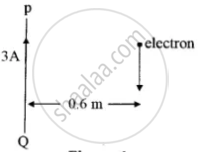
Concept: Magnetic Force
State Biot Savart law.
Concept: Magnetic Field Due to a Current Element, Biot-Savart Law
Two infinitely long current carrying conductors X and Y are kept parallel to each other, 24 cm apart in a vacuum. They carry currents of 5A and 7A respectively, in the same direction, as shown in the figure below. Find the position of a neutral point, i.e., a point where resultant magnetic flux density is zero. (Ignore earth’s magnetic field).
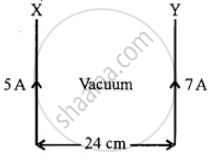
Concept: Force on a Current - Carrying Conductor in a Uniform Magnetic Field
Define Ampere in terms of force between two current carrying conductors.
Concept: Force Between Two Parallel Currents, the Ampere
A long straight wire AB carries a current of 5A. P is a proton travelling with a velocity of 2 × 106 m/s, parallel to the wire, 0.2 m from it and in a direction opposite to the current, as shown in Figure below. Calculate the force which magnetic field of the current carrying conductor AB exerts on the proton.
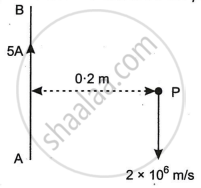
Concept: Magnetic Force
A moving coil galvanometer of resistance 55 Ω produces a full scale deflection for a current of 250 mA. How will you convert it into an ammeter with a range of 0 - 3A?
Concept: Moving Coil Galvanometer
Using Ampere’s circuital law, obtain an expression for magnetic flux density ‘B’ at a point near an infinitely long and straight conductor, carrying a current I.
Concept: Ampere’s Circuital Law
Lorentz force in vector form is ______.
Concept: Magnetic Force
Assertion: When an electric current is passed through a moving coil galvanometer, its coil gets deflected.
Reason: A circular coil produces a uniform magnetic field around itself when an electric current is passed through it.
Concept: Moving Coil Galvanometer
Using Biot-Savart law, show that magnetic flux density 'B' at the centre of a current carrying circular coil of radius R is given by: `B = ("μ"_0I)/(2R)` where the terms have their usual meaning.
Concept: Magnetic Field Due to a Current Element, Biot-Savart Law
When current flowing through a solenoid decreases from 5A to 0 in 20 milliseconds, an emf of 500V is induced in it.
- What is this phenomenon called?
- Calculate coefficient of self-inductance of the solenoid.
Concept: Ampere’s Circuital Law
The figure below shows a circuit containing an ammeter A, a galvanometer G and a plug key K. When the key is closed:
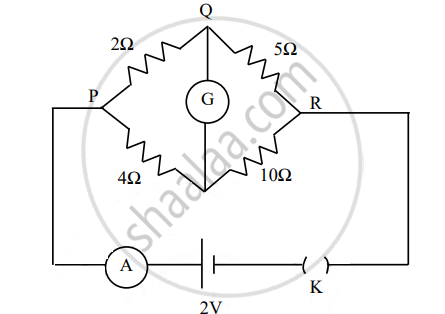
Concept: Moving Coil Galvanometer
A circular coil having N turns of radius R carrying a current I is used to produce a magnetic field B at its centre O.
If this coil is opened and rewound such that the radius of the newly formed coil is 2R, carrying the same current I, what will be the magnetic field at the centre O?
Concept: Torque on a Current Loop in Magnetic Field
The figure below are two long, parallel wires carrying current in the same direction such that I1 < I2.
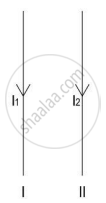
- In which direction will wire I1 move?
- If the direction of the current I2 is reversed, in which direction will the wire I1 move now?
Concept: Force Between Two Parallel Currents, the Ampere
A galvanometer of resistance 100 Ω gives a full-scale deflection for a potential difference of 200 mV.
- What must be the resistance connected to convert the galvanometer into an ammeter of the range 0-200 mA?
- Determine resistance of the ammeter.
Concept: Moving Coil Galvanometer
An electron moving along positive X axis with a velocity of 8 ×107ms-1 enters a region having uniform magnetic field B = 1.3 × 10-3 T along positive Y axis.
- Explain why the electron describes a circular path.
- Calculate the radius of the circular path described by the electron.
Concept: Torque on a Current Loop in Magnetic Field
